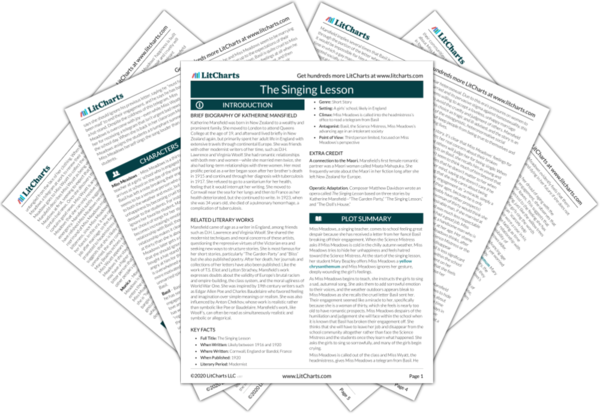Brief Biography of Katherine Mansfield
Katherine Mansfield was born in New Zealand to a wealthy and prominent family. She moved to London to attend Queens College at the age of 19, and afterward lived briefly in New Zealand again, but primarily spent her adult life in England with extensive travels through continental Europe. She was friends with other modernist writers of her time, such as D.H. Lawrence and Virginia Woolf. She had romantic relationships with both men and women—while she married men twice, she also had long-term relationships with three women. Her most prolific period as a writer began soon after her brother’s death in 1915 and continued through her diagnosis with tuberculosis in 1917. She refused to go to a sanitarium for her health, feeling that it would interrupt her writing. She moved to Cornwall near the sea for her lungs and then to France as her health deteriorated, but she continued to write. In 1923, when she was 34 years old, she died of a pulmonary hemorrhage, a complication of tuberculosis.
Other Books Related to The Singing Lesson
Mansfield came of age as a writer in England, among friends such as D.H. Lawrence and Virginia Woolf. She shared the modernist techniques and moral concerns of these artists, questioning the repressive virtues of the Victorian era and seeking new ways to structure stories. She is most famous for her short stories, particularly “The Garden Party” and “Bliss” but she also published poetry. After her death, her journals and collections of her letters have also been published. Like the work of T.S. Eliot and Lytton Strachey, Mansfield’s work expresses doubts about the validity of Europe’s brutal racism and empire-building, the class system, and the moral ugliness of World War One. She was inspired by 19th century writers such as Edgar Allen Poe and Charles Baudelaire who favored feeling and imagination over simple meanings or realism. She was also influenced by Anton Chekhov, whose work is realistic rather than symbolic like Poe or Baudelaire. Mansfield’s work, like Woolf’s, can often be read as simultaneously realistic and symbolic or allegorical.
Key Facts about The Singing Lesson
-
Full Title: The Singing Lesson
-
When Written: Likely between 1916 and 1920
-
Where Written: Cornwall, England or Bandol, France
-
When Published: 1920
-
Literary Period: Modernist
-
Genre: Short Story
-
Setting: A girls’ school, likely in England
-
Climax: Miss Meadows is called into the headmistress’s office to read a telegram from Basil
-
Antagonist: Basil, the Science Mistress, Miss Meadows’s advancing age in an intolerant society
-
Point of View: Third person limited, focused on Miss Meadows’s perspective
Extra Credit for The Singing Lesson
